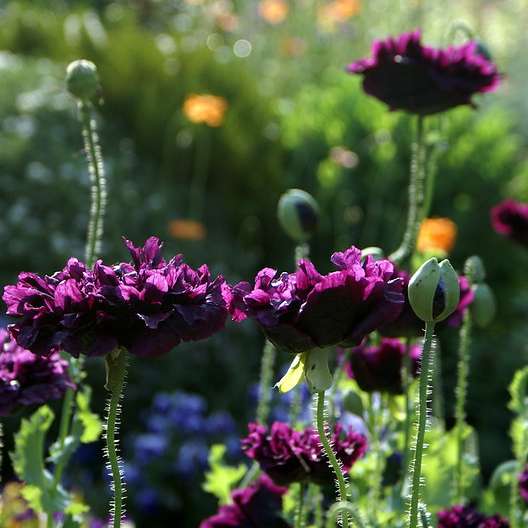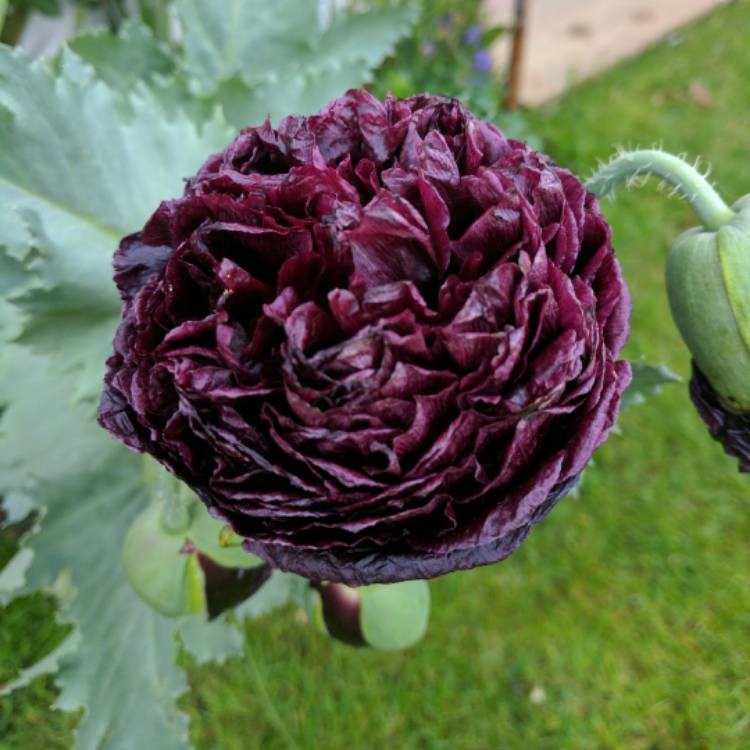Papaver paeoniflorum - Poppy
Papaver paeoniflorum - Poppy
Black Peony Poppy
Couldn't load pickup availability
Sustainably Grown Organic Papaver paeoniflorum
An intriguing and unique poppy with dark, moody blooms. The black poppy makes a striking addition to the spring garden.
🏵️ The Flowers
The large 4-inch wide flowers open in late spring in shades of deep purple-black. As they mature, the silky petals develop crimson undertones. Each crinkly petal has a satiny sheen.
The blossoms are borne on slender upright stems that move gracefully with breezes. While short-lived as cut flowers, their fleeting beauty can be enjoyed up close in a vase indoors.
💐 Planting Partners
Careful consideration of planting partners allows the black poppy's dramatic presence to truly shine. Against a cool backdrop of white or pastel flowers like baby's breath, pastel Achilleas or a white Cosmos, the inky blooms are arresting.
Silver or grey-leafed plants like artemisia act as an excellent foil to silhouette the intricate details of the black petal's crinkled texture and highlights.
For a bold look, the dark poppies can be partnered with vibrant warm shades like fire-engine red, orange or hot pinks such as Dahlia 'Sunny Reggae'. For something softer, blend the black poppy with misty shades of lavender, pale lemon or apricot hues. The velvety flowers are highlighted in these pastel shades
🌿 Self-Sowing
While relatively short bloomers, black poppies often self-sow in mild climates, resulting in returning patches year after year. Dried seed pods can be collected to scatter for future seasons as well.
Plant care guide
Plant care guide
How to Plant Annual Flowers
Annual flowers can be transplanted out after danger of frost has passed.
Dig a hole slightly wider than the rootball or pot, but no deeper. The top of the rootball should be level with the surrounding soil surface.
Water the planting hole, then just pop the woodfibre container straight into the ground and firm the soil gently back in around it ( Do not firm the soil down hard! Roots need air and water and hard compacted soil prevents them from getting both.).
There is no need to remove the pot as will degrade quickly in the soil.
After planting water thoroughly and keep the soil moist but not soaked until the plants become established. Mulching with something like woodchips around the plant after watering will help the soil to retain the moisture in hot weather.
When to Plant Annuals
The ideal planting time depends on where you live and your local climate (or even microclimate!), but most annuals can be sown or transplanted after the last spring frost date. Some cool season annuals like snapdragons and sweet peas can go out even earlier.
Warm season annuals like zinnias and marigolds you should wait until nights remain above 10°C.
If planting in hot weather, cut the foliage and flowers back. Your new plant will not be taking up much water until established so may struggle if the leaves lose more water than the roots can absorb.
Where to Plant Annuals
Most annuals need at least 6 hours of full sun per day for best flowering - they’re powerful growers that are literally dying to set seed so let them have the sunpower to get there!
Pay attention to the soil. if it is heavy clay, incorporate organic matter such as compost to the soil before planting your perennial, preferably to the whole flowerbed. This will improve the soil by buffering it's water and nutrient holding ability. It is preferable to not just plonk compost in the bottom of the hole as it will not improve the overall condition of the soil surrounding your new plant. Do not add a layer of gravel or grit to the bottom of the hole as this will merely cause the perched water table to be higher. It will not improve drainage.
Also, remember to consider mature plant size and space accordingly in beds and containers. Taller annuals work well in the back, with smaller types in front.
Caring for Annual Flowers
Keep soil consistently moist through the growing season by watering whenever the top inch becomes dry. Apply a 2-3 inch layer of mulch after planting to conserve moisture.
The vast majority of garden soils contain plenty of nutrients, but if your garden is in a newly built development there is a good chance a thin layer of topsoil has been added on top of infertile subsoil. if that is the case, compost, soil improver or well rotted manure can be spread on the flower bed and dug in, or alternatively for those short of time or energy, organic fertiliser such as our own special organic mix of bone meal, hoof and horn and vinaase that is an organic, sustainable alternative to the John Innes formula, can be sprinkled around the plant with some compost added to the planting hole.
Deadhead spent flowers regularly by pinching or cutting them off. This will encourage more buds and prolong the bloom period.
Pull up annual plants at the end of the growing season and add to the compost pile. Their entire life cycle lasts just one season.
Container grown annuals may need more frequent watering and fertilising than in-ground plants as soil dries out faster.
Delivery £5 flat rate or FREE over £50 spend.
Delivery £5 flat rate or FREE over £50 spend.
I charge a flat rate of £5 for postage and packaging to all of Britain, including the Highlands and the Isle of Man, with free delivery for orders over £50. We are unable to send plants to Northern Ireland.
I use Royal Mail for our deliveries as they have the lowest carbon footprint per parcel delivered in the UK and actually tend to look after parcels rather than just chucking them over the nearest fence! This ensures that your plants will have the best care possible.
Please have a Safe Place set up if possible so your plants are not returned to the sorting office if no one is home to accept the delivery.
I try to dispatch plants twice a week and you will receive updates by text or email. In cases of extreme weather or if Royal Mail has a hiccup the delivery may be delayed but we'll keep you in the loop.
I'm unable to deliver to the Channel Islands or Northern Ireland5
The LAWNMOWER Guarantee
The LAWNMOWER Guarantee
Healthy plants & happy customers
Your plant will only be dispatched if I'm happy it is healthy. The nature of growing the plants in large troughs means that the root system will be trimmed before they are balled in hessian, and therefore, depending on the time of year, the top growth may also be trimmed to make sure the roots are able to supply the water and nutrients your new plant requires.
Pruning encourages new growth and this applies to roots as well so a pruned plant actually results in a stronger plant.
The LAWNMOWER guarantee.
If you're not happy with your plants for any reason, even if you've run them over with your lawnmower, just pop them in a box (the plants, not the mower!) and post them back to us within 1 year for a replacement or refund.
This does not affect your statutory rights.
For full details check out the Refunds and Returns Policy.
Sustainability
Sustainability
Eco-friendly business
Fed up with plants grown in plastic pots which are doused in herbicides and sprayed with synthetic chemicals by big nurseries who merrily burn through finite resources, fly plants in from abroad on jet planes, irresponsibly use peat and coir, kill any insect nearby with non-selective pesticides and generally only think of the bottom line?
So are we!
How we grow plants sustainably
Our plants are started in coldframes or inside our house, grown-on woodfibre pots or in reclaimed wooden troughs which are then carefully harvested and balled and burlapped (hessian wrap securing the rootball), before packing plastic free in a eco cardboard box from a certified B-corp carbon neutral supplier. Some plants are grown in 8cm woodfibre pots.
Sustainable and organic compost & fertiliser
Our Soil Association certified organic compost is bought in bulk without plastic bags from Dalefoot Compost, and consists of sheep wool, bracken and comfrey. This naturally feeds the plants for 12 months. If supplemental feeding is required we only use our own special blend of organic fertilisers (bone meal, hoof & horn and vinaase) which have been processed with solar energy.
Carbon Neutral business
The small amount of electricity we use is from renewable sources and we irrigate our plants with stored water we have harvested. Plus, we are using our house and land for more than one purpose, preventing further land use and utilising the sunk carbon cost of the building rather than creating more.
We have partnered with Carbon Neutral Britain to offset our emissions, and recognise that we are not in control of all parts of the supply chain so have fully offset scopes 1, 2 and 3 to take that in to account - so that's all emissions connected to our business, from the farts coming out of the back of the sheep, to the carbon dioxide from the delivery van outside your door.
We don't just offset and carry on, ALL the decisions we make work to reduce emissions - for instance we use Royal Mail to post our plants as they have by far the lowest carbon footprint per parcel delivered in the UK.
Papaver paeoniflorum
View full details



